Preparing an Old Home for Electrification, Part 2
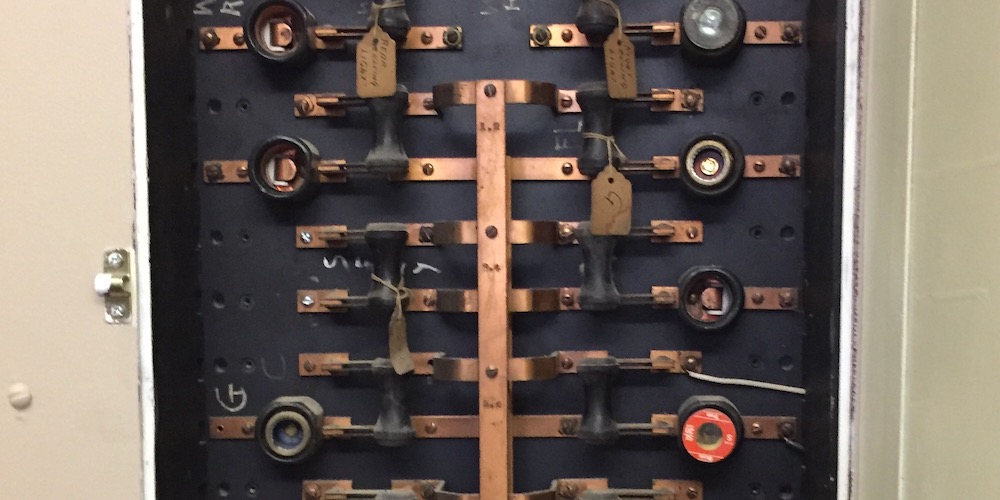
The electrification movement is accelerating, so let’s go back to this topic again and look at how to electrify an older house. In part 1 of this series, I listed some important questions to ask. Today, I’ll cover some steps that can make the transition to an all-electric home easier. I’m not going to get into incentives, but the Inflation Reduction Act (IRA) is putting a lot of money out there to help with changing out fossil fuel appliances with electric versions. And that’s not all. The IRA also can help you get the electrical system upgraded if necessary.
But first, let me put a little disclaimer out here. Making changes to your house can be dangerous. It can go wrong in many ways. Working with electricity requires a level of skill and attention that doesn’t suit every do-it-yourselfer. The suggestions I give below are meant to be general advice to get you thinking in the right direction. Don’t take on projects that you aren’t competent to complete. Call an electrician or other qualified professional when necessary.
Plan your conversion
Start with an inventory of your current fossil fuel-burning combustion equipment. Go through the house and determine what fuel is used for your:
- Heating system
- Fireplace
- Water heater
- Clothes dryer
- Range
Once you know where you’re using gas, oil, or propane, you’ll need to decide how far down the electrification path you want to go. All the way? Heating only? All but one appliance?
Once you have that, assess the age and condition of each appliance you want to replace. If they’re old and less efficient than newer models, you have a good incentive to make the switch. You need to replace them anyway, and going to a high-efficiency electric model can help pay for the conversion.
If you’re afraid to switch from a furnace to a heat pump, one thing you can do is go to a dual fuel system. It heats with a heat pump down to a certain temperature and then switches over to the furnace. See my recent article on dual fuel heat pumps.
Finally, come up with a timeline. Do you want to do it all at once? Or make the conversion over an extended period, say five years? The more you have to do—and spend—to convert, the longer it may take you to get it all done.
Do you need a wiring upgrade?
The big obstacle that can turn what seems like a simple conversion into an expensive upgrade is the current state of your electrical system. Wiring in older homes is often a mess. If your home still uses knob-and-tube wiring (photo below), that’s a mandatory conversion. It’s a fire risk and you should take care of that right away. Get an electrician to evaluate the wiring and see if you need to make any general changes.
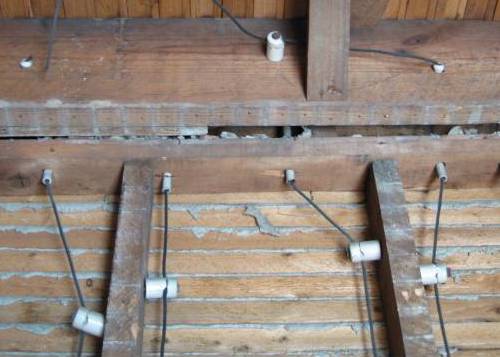
Do you need a panel upgrade?
Then there’s the electrical panel. If yours looks like the one in the lead photo above, it’s definitely due for an upgrade. If it looks like a standard breaker box, you may be OK. The next step is to find out what the maximum capacity of the panel is and how close you come to it. New homes these days generally come with a 200 amp (A) service, but older homes may have a maximum of only 100 A or less.
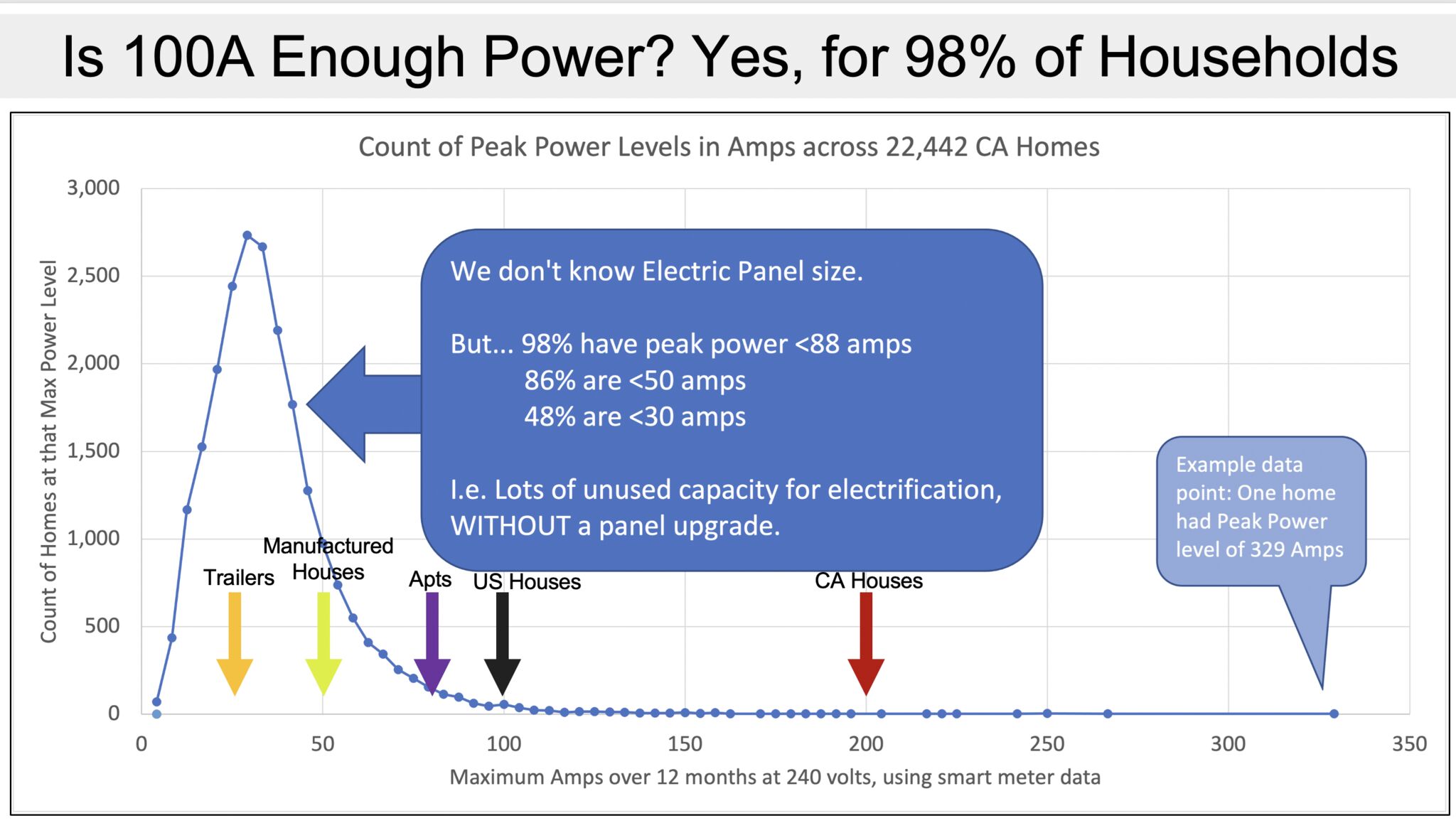
The good news is that a great many homes with smaller electrical services are still OK to go all-electric. Home Energy Analytics got electric utility data for more than 22 thousand customers in California and analyzed their peak power usage. The graph above tells the tale. A measly 2% had peak electrical current greater than 88 amps, and 86% had peaks below 50 amps.
Find your peak electrical current
That’s great news for those older homes because it means the majority can go all-electric without needing a panel upgrade. Of course, to proceed without a panel upgrade, you’ll need to have an idea of what your peak current level is. Then you’ll have to find out how much electrical load it will add to switch fuels.
For example, let’s say you have a 100 amp service, and your measured peak current is 45 amps. If the heating and cooling loads are small, you may be able to install an efficient heat pump that adds no more than 20 amps. That brings you to 65 amps total. That still leaves 35 amps, which should be enough to switch to an electric water heater, too. If you want to charge an electric vehicle, though, you may well need an upgrade. Maybe. But see the last section of this article for another option.
One way to get at this is to install a whole-house electricity monitor. I use the Emporia Vue system* and have explained the concept of whole-house electricity monitoring as well as written about my first full year of electricity monitoring data. The smartphone app that goes with the monitor allows you to look at the data in units of power or current.
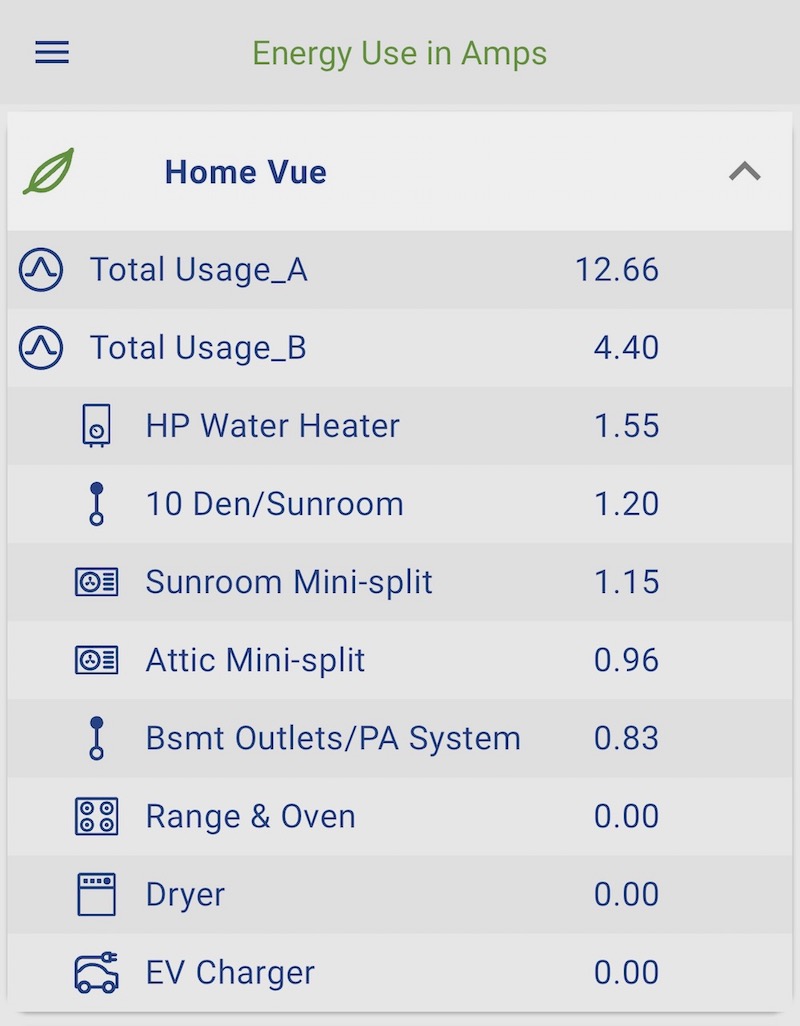
The screen shot above shows the instantaneous current draw in my house on an early September morning when the outdoor temperature is 81 °F (27 °C). We have a 200 amp service, and we were drawing only 17 amps at the time. (You have to add the A and B currents for the total because the electricity comes in through two mains.)
Map your circuits
One problem you may run into even if you have peak capacity to spare is room in the electrical panel. When you switch from a furnace to heat pump or gas to electric water heater, you’ll need to add circuits. But what if every slot in the panel already has a breaker in it?
I went through the exercise of mapping out all the circuits in my house last year, and it helped solve that problem for me. All the slots in my panel were being used, leaving no room to add more. But when I mapped out every room and electrical load in the house, I found a few circuits that were no longer in use or no longer needed. Also, there were a couple of places where circuits could be combined. Read my full article on circuit-mapping for more detail.
Electrification tidbits
Once you go through the steps above, you’ll have a good idea about how to approach the electrification of your house. Be sure to check out other resources, too. See the Home Energy Analytics page on electrification, where the graph above came from. And a great resource to help you reduce your load is the Watt Diet Calculator from Redwood Energy.
Also, there are a lot of new products that can help. Circuit splitters, for example, let you share one circuit between two loads. Let’s say you already have an electric dryer and want to add a charger for an electric vehicle. A circuit splitter can allow you to add the EV charger without adding another circuit. You plug both into the splitter, and it allows only one to run at a time.
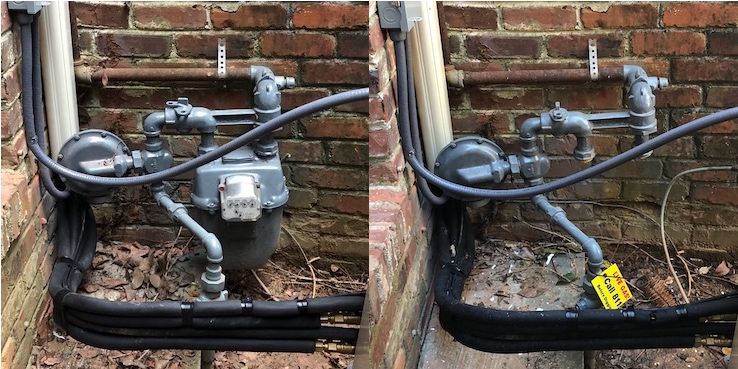
These are exciting times in the world of electrification. I took my house all-electric in 2019 and am loving it for a bunch of reasons (single fuel, combustion safety, indoor air quality, gas ). That’s the before and after above, showing the gas meter removed.
Have you already electrified? If not, are you thinking about it?
Warning: Making changes to the electrical system in your house can be dangerous. It can go wrong in many ways. Working with electricity requires a level of skill and attention that doesn’t suit every do-it-yourselfer. The suggestions above are meant to be general advice to get you thinking in the right direction. Don’t take on projects that you aren’t competent to complete. Call an electrician or other qualified professional when necessary.
Allison A. Bailes III, PhD is a speaker, writer, building science consultant, and the founder of Energy Vanguard in Decatur, Georgia. He has a doctorate in physics and is the author of a bestselling book on building science. He also writes the Energy Vanguard Blog. For more updates, you can subscribe to the Energy Vanguard newsletter and follow him on LinkedIn.
Related Articles
Preparing an Old House for Electrification, Part 1
The Easy Way to Switch to a Heat Pump
Introduction to Whole-House Electricity Monitoring
The #1 Reason to Have an All-Electric Home
An Electrification Essential: Electrical Circuit Mapping
* This is an affiliate link. You get 5% off the list prices, and Energy Vanguard may make a small commission if you buy after using the link. You can also get the discount by going to https://shop.emporiaenergy.com/ and entering the discount code energyvanguard at checkout.
Comments are moderated. Your comment will not appear below until approved.
This Post Has 11 Comments
Comments are closed.


Allison, thank you, enjoyed reading your news #187!
We built our current home in 2019. It is in a subdivision with all the 20th century utilities available along the street: electric, natural gas, sewer, water. We made a decision not to even bother with a gas connection.
Our biggest users and their max Amp loads at 240V are:
1. cooktop = 43.75Amp (theoretical, I don’t remember ever firing up all elements at the same time)
2. ducted minisplit system with 3 indoor units= 42Amp (LRA)
3. EV charger = 30Amp
4. wall oven = 15.4Amp
5. heat pump water heater = ~12Amp (we never run it in resistance heat mode)
6. ventless condenser dryer = 12Amp
7. and the usual rest @120V: microwave = 14Amp, toaster oven = 12.5Amp, dishwasher = 8Amp, fridge = 3Amp
(note that the Amp values for compressor type appliances like the minisplit, hpwh, or condenser dryer represent peak current needed to start their motors)
Paul: My quick sum of your loads gives me just a bit less than 200 amps. But the thing about electrical loads (same with heating, cooling, and hot water) is that it would take extraordinary circumstances for them all to be running at once. Have you done any monitoring to see what you actual max current might be?
Allison, monitoring is on my to-do list. You’re right, it is unlikely, although NEC requires and has procedures laid out for main service panel load calculation. This, in my experience, is seldom checked in new construction (single-family), and left to the electrician on the project to do it right.
The EV chargers have become one of the largest and most consistent current users in single-family homes. There are very few, if any, appliances that draw 25+Amp for hours on end.
One advice I would give to those planning on doing major upgrades in preparation for going all-electric: involve your local jurisdiction’s building inspector. An electrical permit to do panel replacement and some rewiring will be inexpensive compared to a roll of Romex these days! Whether you’re doing the work yourself, or hire an electrician, an inspector can be an additional set of eyes to catch mistakes, or even give you tips.
My previous house was all electric with a 200 amp panel. I found the “extraordinary circumstance” that tripped the main breaker. A utility transformer failed and we lost power for several hours on a winter day. When the power was restored, two heat pumps with strip heat and an electric resistance water heater all came on to recover the drop in temperature during the outage. I turned on the microwave and that was enough to trip the main breaker. What we need is smarter appliances that don’t immediately turn on after a power outage. There needs to be some kind of staging or at least a time delay to prevent this from happening.
When I am home during a power outage, I would like to turn off the heat pump so that I can turn it back on manually after the power is restored and line voltage is stable. Unfortunately, I can’t do that because I have electronic thermostats that cannot be turned off until the power is restored. I guess I could flip breakers, but that is not as convenient.
I have a house on southwestern Pa with a 140,000 BTU oil furnace, no AC. I am looking at a whole house heat pump, maybe 5 tons. The load center is a 200 A. unit with empty spaces. By the way, house was built in the late 1800’s, plaster walls, some insulation in the attic. 2900 square ft on two levels with a basement under about half of the structure. Any advice would be appreciated.
It’s worth mentioning: if you’re installing high amp appliances, you should consider spending the extra few bucks on the higher end receptacles, and DEFINITELY use a torque screwdriver/wrench for the connections. Everybody should be torquing all screw connections as is, but I’m basically the only one who bothers. It’s just way more important with the higher amp draws for electrified homes.
I agree with Alexander. I had problems with a range hood not working at all and some GFCI outlets not working. I went into the panel to check the connections on the neutral and ground bus bars and could easily tighten each screw a half turn. This solved my problems. I would imagine the original electrician properly tightened these connections but the bus bar might have “stretched” since then.
The electricians said people get way too worked up over knob and tube, especially as it relates to lighting. People get in trouble when they plug in window units and hair dryers or pile insulation on top of it so it can’t work as intended. Their advice was to install air conditioning and not worry about the knob and tube.
We did just that and are very happy with the heat pump as part of a dual fuel system
Hi Allison,
When talking about “every slot in the panel already has a breaker in it”, is that before or after replacing some of the 15 and 20 amp breakers with skinnier, two per slot(?) models? Though I suspect there is a limit to how far one could take that approach.
Some of mine are split and others aren’t. The last time an electrician came over, I was told it would not work to have any more wires running through the circular hole under the 200 amp panel because it was already too tight.
Allison,
“(You have to add the A and B currents for the total because the electricity comes in through two mains.)”
Your 200 amp service would actually have a continuous load capacity of 160 amps (80% of breaker rating)
Each phase “A” and “B” would be individually rated for this load. (continuous load per NEC is considered 3 hours or more.) The typical circuit breaker is thermal/magnetic and will handle 100% load, and can carry over 100% loads for a short period of time without any issues, such as the starting current for compressors and motors. We typically refer to loads in watts as it takes into account the different voltage needs of the circuits.
As you mentioned there are very few loads that would run “continuously”, EVSE’s are probably one of the few heavy loads that would meet this criteria. (unless someone was running a HP mini-split during a 100 year artic blast) 🙂 The 120 volt loads are typically minimal and short term, and only affect the phase they are connected to.
With the efficiency increases in appliances and home construction the common 200 amp services are more than adequate for most homeowners. EV’s may be the outlier to electrical needs.
As you mentioned there are circuit splitters for EVSE’s , also people with multiple EV’s can use smart EVSE’s. They will throttle the load for multiple EV’s charging at the same time so they will limit the amperage to only one circuit.